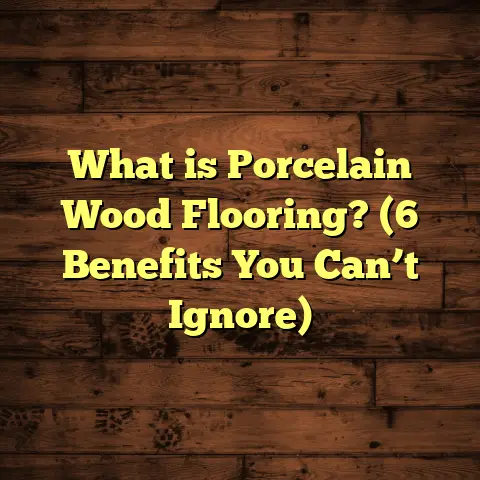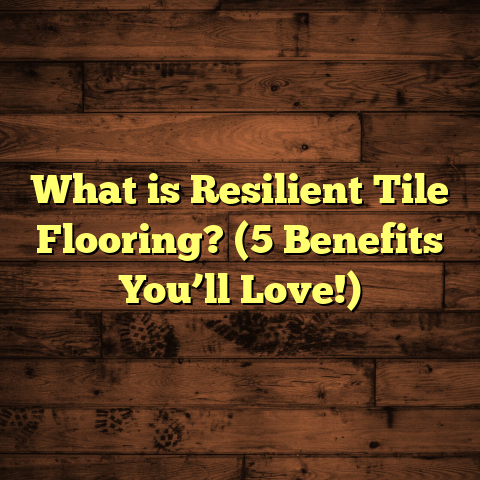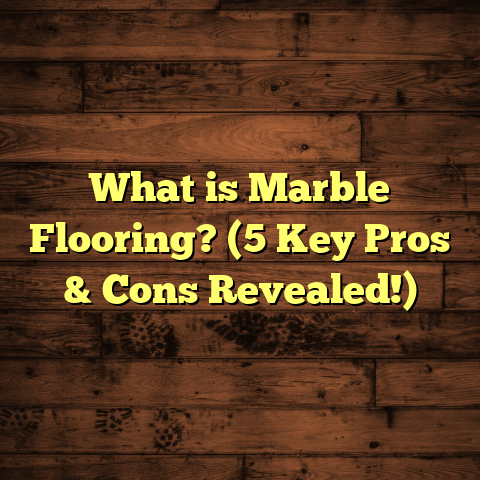What is Average Cost to Install Vinyl Flooring? (5 Key Factors)
What is the Average Cost to Install Vinyl Flooring?
Let me start by sharing what I often hear from homeowners: “I want new floors, but I have no clue how much vinyl flooring installation costs.” This is a common challenge. Vinyl flooring is a popular choice for many because it blends affordability with style and durability. Yet, when someone asks about the cost of installing vinyl flooring, the answer isn’t simple.
Why? Because the price depends on many moving parts. Every job I’ve done over the years has taught me that understanding these parts can help you avoid surprises and manage your budget effectively. Today, I want to walk you through everything I’ve learned about vinyl flooring installation costs based on real-world projects, research, and my hands-on experience.
I’ll break this down into five key factors that influence the cost and share actionable tips that you can use whether you want to DIY or hire a pro.
The Basics of Vinyl Flooring Installation Costs
Before we get into the factors affecting costs, it’s helpful to quickly cover what goes into a vinyl flooring installation project. This isn’t just about buying a roll of vinyl or a box of planks—there are multiple steps and materials involved:
- Measuring the space: To know how much material you need.
- Choosing the vinyl type: Sheet, tile, or plank; basic or luxury.
- Preparing the subfloor: Repairing or leveling if needed.
- Installing underlayment: Sometimes required for comfort and moisture barrier.
- Laying the vinyl: Gluing down or click-lock installation.
- Adding trims and transitions: To finish edges and doorways.
- Cleanup and inspection: Checking for flaws or necessary fixes.
Each step adds time, labor, and sometimes extra materials to your total cost.
1. Material Quality and Type: How Much Does Your Vinyl Cost?
There’s a huge range in vinyl flooring prices because there are so many types on the market today. When I first started installing vinyl years ago, it was mostly sheet vinyl glued down in kitchens or bathrooms. Now, luxury vinyl planks (LVP) and tiles (LVT) dominate because they look so realistic and feel great underfoot.
Sheet Vinyl vs. Luxury Vinyl Plank/Tile
Here’s a breakdown of average material costs per square foot based on my experience and recent market data:
| Vinyl Type | Cost per sq ft (Material Only) |
|---|---|
| Basic Sheet Vinyl | $0.50 – $2 |
| Mid-Range Sheet Vinyl | $2 – $3 |
| Luxury Vinyl Plank (LVP) | $2 – $7 |
| Luxury Vinyl Tile (LVT) | $3 – $8 |
I remember one job where the homeowner wanted a budget-friendly option for their basement. We went with basic sheet vinyl at about $1.25 per sq ft. It looked clean but wasn’t as thick or textured as luxury products. For another client’s kitchen renovation, we installed LVP with a wood grain finish that cost nearly $6 per sq ft because durability and appearance were priorities.
Thickness and Durability
Thicker vinyl tends to be more durable and comfortable underfoot. Most basic vinyls are around 2mm thick, while luxury options can be 4mm or thicker with attached underlayment.
- Thicker material costs more upfront but lasts longer.
- In commercial spaces or high-traffic homes, investing in quality pays off.
Design Variety
Luxury vinyl comes in thousands of patterns—wood, stone, ceramic looks—with embossed textures that mimic real materials closely. This variety impacts price too. Custom or rare designs will cost more.
2. Size and Complexity of the Area: How Your Room Shapes the Bill
The size of your room is an obvious cost driver—you need more material and labor for bigger areas. But complexity plays an even bigger role.
Simple vs Complex Layouts
I once installed vinyl in two identical-sized rooms: one was a simple square; the other had multiple doorways, corners, and built-in cabinets.
- The simple room took roughly 6 hours to complete.
- The complex room took nearly double because of all the cuts and fitting.
Cutting planks to fit around irregular corners or obstacles takes time—and time is money when hiring pros.
Odd-Shaped Rooms
Rooms with curves, diagonal walls, or alcoves require more waste material to cut shapes accurately. Expect to pay an additional 10-15% on material for waste in these cases.
Multi-Room Projects
If you’re covering several connected rooms with different floor heights or transitions, labor costs increase as finishing trims are needed for each doorway or step.
3. Labor Costs: How Much Will It Cost to Pay Someone?
This is where location matters a lot.
National Labor Cost Range
Based on my experience working in different states:
| Location Type | Labor Cost per sq ft |
|---|---|
| Urban (NYC, SF) | $3 – $5 |
| Suburban | $2 – $3 |
| Rural | $1.50 – $2 |
Labor pricing models vary too:
- Some contractors charge per square foot.
- Others charge hourly (typically $40-$75 per hour).
- Some include a minimum fee for smaller jobs.
What Labor Covers
Labor includes:
- Removal of old flooring (if applicable)
- Subfloor prep (cleaning, repairs)
- Installation of underlayment
- Laying vinyl with glue or click-lock system
- Finishing edges with trims
When DIY Saves Money (and When It Doesn’t)
I’ve seen DIYers save significant money by installing click-lock vinyl themselves—total savings can be up to 50%. But if you’re not confident in floor leveling or precise cutting, mistakes can lead to costly repairs down the road.
4. Additional Materials: What Else Will You Need?
Many overlook these extras until they show up on the invoice:
Underlayment
Some vinyl comes with attached underlayment; if not, buying separate underlayment adds roughly $0.25-$0.75 per sq ft.
Good underlayment improves comfort, soundproofing, and moisture resistance.
Adhesives
Glue-down vinyl requires adhesive costing about $0.50 per sq ft. Not every job needs glue—click-lock planks snap together without adhesive.
Floor Prep Materials
- Patching compounds for uneven floors: $20-$50 per bag
- Moisture barriers in basements: $0.25-$0.50 per sq ft
Trims and Transition Strips
These finishing pieces can add several hundred dollars depending on room count:
- Baseboards: $1-$3 per linear foot
- Transition strips between different flooring types: $3-$10 each
5. Waste Factor: How Much Extra Vinyl Should You Order?
Material waste isn’t just “extra.” It’s essential for cuts, errors, and future repairs.
Typical Waste Percentages
- Simple rooms: 5% waste
- Complex rooms: 10% waste
- Patterned installations: up to 15%
When I order material for clients, I always add at least 10% over their measured square footage to cover waste.
Real Example
A client’s 350 sq ft living room with angled walls required ordering 385 sq ft of LVP to account for cuts and mistakes.
Deep Dive Case Studies from My Projects
I want to share three detailed project examples from my recent work that show how these factors come together.
Case Study #1: Small Bathroom Vinyl Installation
- Room size: 50 sq ft
- Vinyl type: Basic sheet vinyl at $1.75/sq ft
- Labor rate: $2/sq ft
- Waste factor: 5%
- Underlayment: Not required
- Adhesive: Included in labor cost
Cost breakdown:
| Item | Cost per sq ft | Total (52.5 sq ft incl waste) |
|---|---|---|
| Vinyl material | $1.75 | $91.88 |
| Labor | $2 | $105 |
| Adhesive & extras | Included | $0 |
| Total Cost | $196.88 |
This was a quick job completed in a day with minimal prep required.
Case Study #2: Large Open Kitchen + Dining Room
- Room size: 500 sq ft
- Vinyl type: Mid-range LVP at $3.50/sq ft
- Labor rate: $2.50/sq ft
- Waste factor: 10%
- Underlayment: Included with product
- Adhesive: Not needed (click-lock)
Cost breakdown:
| Item | Cost per sq ft | Total (550 sq ft incl waste) |
|---|---|---|
| Vinyl material | $3.50 | $1925 |
| Labor | $2.50 | $1375 |
| Underlayment | Included | $0 |
| Adhesive | Not needed | $0 |
| Transition strips | Per job | $200 |
| Total Cost | $3500 |
This project took three days due to careful cuts around islands and appliances.
Case Study #3: Basement Renovation with Moisture Barrier
- Room size: 800 sq ft
- Vinyl type: Luxury LVT at $5/sq ft
- Labor rate: $3/sq ft
- Waste factor: 10%
- Underlayment & moisture barrier separate
Cost breakdown:
| Item | Cost per sq ft | Total (880 sq ft incl waste) |
|---|---|---|
| Vinyl material | $5 | $4400 |
| Labor | $3 | $2640 |
| Underlayment | $0.50 | $440 |
| Moisture barrier | $0.40 | $352 |
| Adhesive | Included | $0 |
| Total Cost | $7832 |
This was a complex project requiring extensive prep due to moisture concerns.
Extra Tips from My Experience That Save You Money
I’ve learned a few things that help homeowners get the best price without sacrificing quality:
Tip #1: Combine Rooms When Possible
Installing vinyl across multiple adjacent rooms at once usually lowers labor costs because contractors can work continuously without resetting tools or moving bulky equipment repeatedly.
Tip #2: Avoid Peak Seasons for Installation
In spring and early summer, contractors are busiest—and prices can rise due to demand.
Booking fall or winter projects might save you some money.
Tip #3: Prep Your Space Before Pros Arrive
Clearing furniture, removing old carpet or tile yourself can shave hours off labor time.
I had one client save over $300 this way on a mid-sized project.
Tip #4: Ask About Warranty Coverage
Some premium vinyl brands offer better warranties which can save future repair costs if accidents happen within coverage periods.
Frequently Asked Questions About Vinyl Flooring Costs
How do I measure my room accurately?
Measure length x width for simple rooms. For irregular spaces, break into rectangles and add areas together.
Always add waste—at least 10%.
Is it cheaper to install vinyl over existing floors?
Usually yes, if subfloor is flat and clean. Removing old floors adds labor and disposal fees.
What maintenance costs should I expect after installation?
Vinyl is low-maintenance—sweeping and occasional mopping usually suffice.
Avoid abrasive cleaners that damage finish.
Summary of Average Costs in Different Scenarios
| Project Type | Total Cost Range per sq ft |
|---|---|
| Basic Sheet Vinyl Installation | $2 – $4 |
| Mid-range LVP Installation | $4 – $6 |
| High-end LVT Installation | $6 – $9 |
These ranges include materials and labor but exclude major subfloor repairs or demolition work.
Final Thoughts on Budgeting for Your Vinyl Floor Project
Vinyl flooring offers great flexibility—from budget basics to high-end luxury looks—but understanding all factors that affect installation costs helps you plan efficiently.
For most projects, expect about half your budget on materials and half on labor plus extras like adhesives and trims.
Using tools like FloorTally or getting multiple local quotes can give you precise estimates customized to your needs.
And remember—investing a bit more upfront in quality materials and professional installation pays off in longevity and satisfaction down the road.
If you want personalized advice for your project or need help breaking down quotes from contractors, just reach out! I’m happy to share what I’ve learned over the years so you get beautiful floors without overspending.





